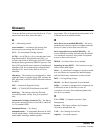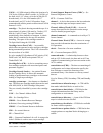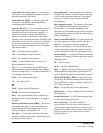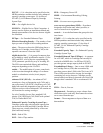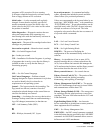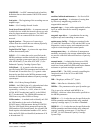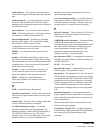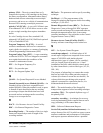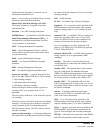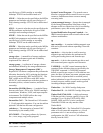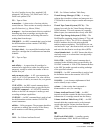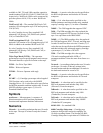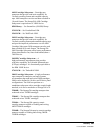
1st ed., 6/30/04 - 312579601
662 VM/HSC 6.0 System Programmer’s Guide
LMUPDEF— An HSC command used to load the
definition data set that contains LMUPATH control
statements.
load point— The beginning of the recording area on
magnetic tape.
loader— See Cartridge Scratch Loader.
Local Area Network (LAN)— A computer network
in which devices within the network can access each
other for data transmission purposes. The LMU and
attached LCUs are connected with a local area
network.
logical ejection— The process of removing a
volume from the control data set without physically
ejecting it from its LSM location.
Logical End Of Tape— A point on the tape where
written data normally ends.
LONG— (1) A value that can be specified on the
MEDia parameter and that includes only enhanced
capacity cartridge system tapes (not to be confused
with LONGItud). (2) An alias of ECART. (3) See
Enhanced Capacity Cartridge System Tape.
LONGItud— (1) A generic value that can be
specified on the RECtech parameter and includes all
18-track and 36-track devices. (2) A generic value
that can be specified on the MEDia parameter and
includes all standard and enhanced capacity cartridge
system tapes.
LSM— See Library Storage Module.
LSMid— An LSMid (lsm-id) is a hexadecimal value
that consists of the ACSid and LSM number
separated by a colon (i.e., AA:LL, where AA is the
ACSid, 00-FF hexadecimal, and LL is the LSMid,
00-17 hexadecimal). The LSMid differentiates an
LSM from every other LSM in a library.
LSM number— A method used to identify an LSM.
An LSM number is the result of defining the
SLIACS macro LSM parameter during a LIBGEN.
The first LSM listed in this parameter acquires the
LSM number of 00 (hexadecimal), the second LSM
listed acquires a hexadecimal number of 01, and so
forth, until all LSMs are identified (maximum of 24
or hexadecimal 17).
M
machine initiated maintenance— See ServiceTek.
magnetic recording— A technique of storing data
by selectively magnetizing portions of a
magnetizable material.
magnetic tape— A tape with a magnetizable surface
layer on which data can be stored by magnetic
recording.
magnetic tape drive— A mechanism for moving
magnetic tape and controlling its movement.
maintenance facility— Hardware contained in the
CU and LMU that allows a CSE and the RDC to run
diagnostics, retrieve status, and communicate with
respective units through their control panels.
management class— A collection of management
attributes, assigned by the storage administrator, that
are used to control the allocation and use of space by
a data set.
manual mode— A relationship between an LSM
and all attached hosts. LSMs operating in manual
mode have been modified offline and require human
assistance to perform cartridge operations.
master LMU— The LMU currently controlling the
functional work of the ACS in a dual LMU
configuration.
MB— Megabyte, million (10
6
) bytes.
MDS— Main Device Scheduler (JES3).
MEDia— The parameter used to specify media type.
This is not to be confused with MEDIA1 or
MEDIA2, which are values that can be specified on
the MEDia parameter.
MEDIA1— (1) A value that can be specified on the
MEDia parameter and that includes only standard
capacity cartridge tapes. (2) An alias of Standard.
MEDIA2— (1) A value that can be specified on the
MEDia parameter and that includes only enhanced
capacity cartridge system tapes. (2) An alias of
ECART. (3) See Enhanced Capacity Cartridge
System Tape.




